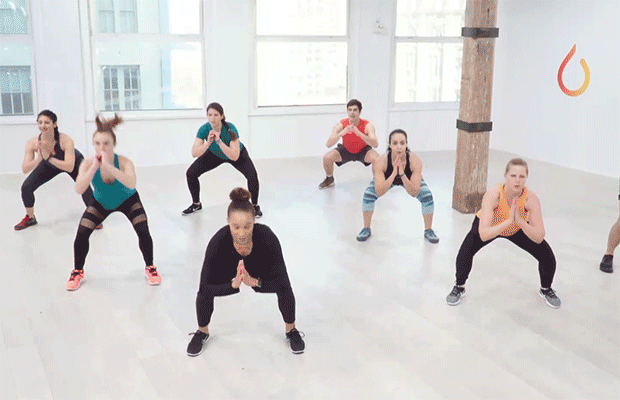Everyone knows that exercise is important to maintain good health, but have you ever wondered why cardiovascular exercise, in particular, is highly recommended by fitness experts? Cardiovascular exercise, also known as cardio, is any form of exercise that increases your heart rate and respiration. It is an essential component that can help keep your heart healthy, boost your mood, and improve your overall well-being.
In this blog, we’ll explore the science behind cardiovascular exercise, its many benefits, the different types of workouts you can try, and how to get started. Whether you’re a beginner or a seasoned fitness enthusiast, we’ve got you covered. So, let’s dive right in and see how you can elevate your fitness game!

What is Cardiovascular Exercise?
Cardiovascular exercise, also referred to as cardio, is any physical activity that raises your heart rate and respiratory challenge. Various exercises activate your heart and cardiovascular system, including weightlifting, stair climbing, cross-country skiing, and more. Cardiovascular exercise is crucial for supplying oxygen to large muscle groups and boosting the heart rate.
Aerobic exercise is a prime example of cardiovascular exercise and includes activities such as brisk walking, heavy cleaning, and playing soccer.
Experts recommend at least 150 minutes of moderate aerobic exercise or 75 minutes of vigorous activity each week. Cardiovascular exercise makes your heart stronger, lowers blood pressure, reduces cholesterol, and makes your body more efficient overall.
Benefits of Cardiovascular Exercise
Cardiovascular exercise is an essential component of a healthy lifestyle and offers numerous benefits to your body, mind, and overall well-being. In this write-up, we will explore some of the most significant benefits of cardiovascular exercise.
#Improves Cardiovascular Health
Cardiovascular exercise is called as such because it works your heart and lungs, helping to strengthen and improve their function. During cardiovascular exercise, your heart rate and respiration rate increase, pumping more oxygen-rich blood to your muscles and vital organs. Over time, regular cardiovascular exercise can improve your cardiovascular health by reducing your risk of heart disease, stroke, high blood pressure, and type 2 diabetes.
#Increases Endurance and Stamina
Cardiovascular exercise is also great for improving your endurance and stamina. By working your heart, lungs, and muscles, cardio exercise helps your body become more efficient at using oxygen and energy. This means that over time, you will be able to perform physical activities for longer periods of time without feeling fatigued or out of breath.
#Helps with Weight Management
Cardiovascular exercise is an effective way to burn calories and lose weight. By increasing your heart rate and working your muscles, cardio exercise can help you burn more calories per hour than many other forms of exercise. Moreover, regular cardio exercise can boost your metabolism, making it easier for your body to burn calories even when you’re not exercising.
#Improves Brain Function and Mental Health
Cardiovascular exercise is not just good for your body; it’s good for your brain too. Studies have shown that regular cardio exercise can improve cognitive function, memory, and mood. Cardio exercise has been shown to increase the production of brain-derived neurotrophic factor (BDNF), a protein that helps to promote the growth and maintenance of brain cells. This can help improve brain function and reduce the risk of cognitive decline as you age. Cardio exercise has also been shown to be effective in reducing symptoms of depression and anxiety.
#Strengthens Bones and Muscles
Cardiovascular exercise can also help to strengthen your bones and muscles. While cardio exercise is not typically associated with building muscle mass, it can help to improve muscle tone and definition. Regular cardio exercise can also help to prevent age-related muscle loss and maintain bone density, reducing the risk of osteoporosis and fractures.
#Boosts Energy Levels
Cardiovascular exercise can help to boost your energy levels and reduce fatigue. Regular cardio exercise has been shown to increase the production of endorphins, the body’s natural feel-good chemicals. Endorphins can help to reduce stress and anxiety, improve mood, and increase energy levels. Additionally, regular cardio exercise can help to improve sleep quality, which can also contribute to increased energy levels during the day.
#Improves Immune Function
Finally, regular cardio exercise can help to improve immune function. Cardio exercise can help to increase the circulation of immune cells throughout the body, helping to improve the body’s ability to fight off infections and diseases. Additionally, regular cardio exercise can help to reduce inflammation in the body, which has been linked to a variety of chronic health conditions.

Different types of cardiovascular exercises
Incorporating a variety of cardiovascular exercises into your fitness routine can help improve overall health and fitness. It’s important to choose activities that you enjoy and that fit your fitness level and goals. Remember to start slowly and gradually increase the intensity and duration of your workouts over time.
- Running: Running is one of the most popular cardiovascular exercises, and for good reason. It requires no equipment and can be done anywhere. Running is a high-impact exercise that can help increase cardiovascular endurance, burn calories, and improve bone density.
- Cycling: Cycling is another low-impact cardiovascular exercise that is easy on the joints. It can be done outdoors or indoors on a stationary bike. Cycling can help improve cardiovascular health, increase leg strength, and burn calories.
- Swimming: Swimming is a great low-impact cardiovascular exercise that can help improve overall fitness. It’s an excellent full-body workout that can help build endurance, strengthen muscles, and improve flexibility.
- Jumping rope: Jumping rope is an effective cardiovascular exercise that can be done at home or at the gym. It requires minimal equipment and can help improve coordination, agility, and endurance.
- Rowing: Rowing is an excellent total-body cardiovascular exercise that can help improve cardiovascular health, increase muscle strength, and burn calories. It can be done on a rowing machine or in a boat on the water.
- Dancing: Dancing is a fun and effective cardiovascular exercise that can help improve cardiovascular health, increase coordination, and burn calories. It can be done in a group fitness class or at home.
- High-intensity interval training (HIIT): HIIT is a type of cardiovascular exercise that involves short bursts of high-intensity exercise followed by periods of rest. It can be done with bodyweight exercises or with equipment like dumbbells or resistance bands. HIIT can help improve cardiovascular health, increase endurance, and burn calories.
- Walking: Walking is a low-impact cardiovascular exercise that can be done anywhere. It’s a great way to improve cardiovascular health, burn calories, and reduce stress.
If you want to begin your cardiovascular exercise journey, start with running, cycling, swimming, and jumping rope. The ideal workout combines aerobic exercise like jogging and biking with resistance training like moderate weightlifting. To ensure cardiovascular health, it is recommended by doctors to do at least 30 minutes of cardio per day on most days.
How to get started with cardiovascular exercise?
If you’re new to cardiovascular exercise, it’s essential to start slow and make gradual progress. Walking, swimming, and dancing are some of the easiest exercises to start with. Incorporating 5-10 minutes of high-intensity exercise 2-4 times per week is crucial – all that matters is consistency. Gradually increase the duration and frequency of your exercise routine, beginning with low intensity. Shorter durations can also be beneficial. Aim for 150 minutes of cardio exercise per week for maximum health benefits.
Before embarking on any exercise regimen, remember to consult with your physician. They will help identify if your desired workout routine is fit for your body’s current state. With the right approach, you can enjoy the benefits of cardiovascular exercise and improve your overall health, inside and out.
You May Also Ask For
- How do you develop cardiovascular exercise?
To develop cardiovascular exercise, focus on activities that increase your heart rate and challenge your cardiovascular and respiratory systems. This can include activities such as running, cycling, swimming, or aerobics.
Cardiovascular fitness is important because it helps supply oxygen to your muscles and supports overall body function. To improve your cardiovascular fitness, engage in continuous and rhythmic movements that challenge your heart and lungs.
Improving your cardiovascular fitness can also lead to a stronger heart and lower risks of obesity, diabetes, and heart disease. The American Heart Association recommends at least 150 minutes per week of moderate-intensity activity to maintain good cardiovascular fitness.
- How much cardiovascular exercise should I aim to do each week?
As an adult, it is recommended to aim for at least 150 minutes of moderate-intensity or 75 minutes of vigorous-intensity cardiovascular exercise per week. This can include activities such as brisk walking, swimming, running, or cycling.
Meeting these basic fitness requirements can help older individuals enjoy more independence at home. It is important to note that exercise intensity is categorized as light, moderate, or vigorous, and it’s necessary to speak with a doctor to determine the appropriate amount and type of exercise suitable for an individual’s health and fitness goals.
- What kinds of cardiovascular exercise are best for beginners?
For beginners, easy to moderate distance exercises, interval training, weightlifting, stair climbing, dancing, aerobics, and cross-country skiing are all great options for cardiovascular exercise. These types of exercise help increase heart rate and respiratory system function, and it is recommended to do at least 30 minutes most days of the week.
Combining aerobic exercise with resistance training produces the greatest benefit for preventing and managing heart disease. Beginner workouts like cardio for absolute beginners, elliptical workout for beginners, stationary bike workout for beginners, and brisk walking at moderate intensity are also good options.
- How can I monitor my heart rate during cardiovascular exercise?
To monitor your heart rate during cardiovascular exercise, consider using a heart rate monitor or checking your pulse. Regular cardiovascular exercise can help control risk factors for heart disease, lower blood pressure, and reduce bad cholesterol levels.
Engaging in regular physical activity, such as running, swimming, cycling, dancing, or sports, can also improve heart strength and increase blood and oxygen flow throughout the body. However, it’s important to be cautious and seek medical attention immediately if someone collapses during exercise.
Let’s Sum Up
Cardiovascular exercise is crucial for maintaining a healthy heart, reducing the risk of chronic diseases, and improving overall fitness. Consistency is key when it comes to reaping the benefits of cardio workouts, and it’s important to find a form of exercise that you enjoy to make it sustainable. With a range of options available, from running to group fitness classes, there is something for everyone. Start slow and gradually build up intensity and duration over time to avoid injury and burnout.






